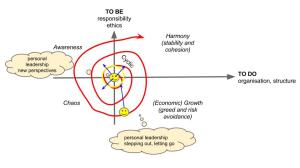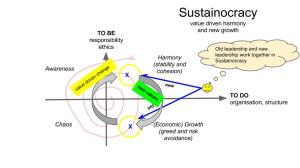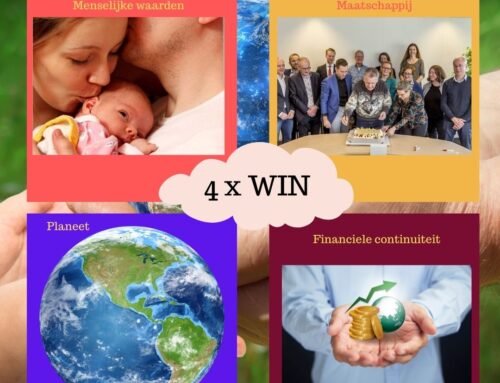When you drive back along a road that you just came from it will look very different even though it is the same road. This is called “perspective”. Often we do not even notice but when it does reach our awareness we refer to it at “perception”. In the global transition of societies perspective and perception are key, for ourselves and especially for our leadership. Perspective refers to the way we look at things, perception gives meaning to the conscious awareness with which we observe and make our choices. Perception is a rational way of awakening. We suddenly experience a “aha”, a flash of thought that illuminates something to the point of a better “understanding” or curiosity to look deeper. In the STIR Foundation we learned to deal with this by helping old leadership change perspective, even when trapped in a specific paradigm. We show them that time and space does not exist. Changing perspective we change the perception of reality. We assume an independent role of new leadership that invites old leadership, acting as catalyst for complex transformations. Let us try to get to an understanding of the phenomenum.
The conscious and unconscious.
We travel the spiral of our life’s complexity chronologically and largely in an admosphere of automated actions. On the one hand our preprogrammed spiritual reality makes us act without thinking and according to the natural patterns of living life in a diversity of life forms and situations. The same patterns we see back in all life forms. It consists of the large cycle of life, beginning with birth, then growth, death and evolution, and in smaller ones (living life) of harmony, greed, chaos and awareness. On the other hand we are conditioned by the human culture in which we live. The spiritual dimensions determine our automated actions while our cultural dimensions determine what our human surroundings expects from us. Both routines are experienced as “normal” and hence do not often get a second thought. It is as if we sleep through life as it does not reach our awareness to make us reflect about the perspective. This goes for leadership too. Unless something happens that wakes us up.
This can be anything. A sudden burst of awareness of a beautiful sunrise that awakens our spiritual senses into our rational mind. Or the loss of a job that makes us panic around sustaining our wellness. The credit crisis that upset the entire financial world. It are these bursts of the conscious breaking through the unconscious that enrich our lives because we become aware and start thinking about it.
The normal flow of a lifetime represents an interaction between the way we conduct our life and the reflection about the consequences of our actions or things that occur in the process that break through into our awareness. We are of course manipulated by the human surroundings that expects from us a certain behavior. This has changed over time and nowadays translates into economic dependencies, growth and consumption. While we live our lives we donot give all this much thought and behave according the patterns that are normalized in our surroundings as long as we get what we need. Noone would think of a transition of society. So what makes these days different?
Burst of awareness
Many things happen these days that make people think and reflect about the daily reality. Global issues, such as global warming, climate change, pollution, poverty, migration, religious conflicts, etc, tend to reach people through the media and often get very close, affecting people personally. The fear for chaos is enough for people to reflect and become aware that things need to change. The natural reaction is than to pinpoint at government and the responsibility of our political leaders. When these leaders seem to be wound up in their own culture of power and system dependencies the problems only seem to get worse. A difference in perception develops between the way society is managed and the way people see it. Society is not united anymore and conflicts arise against authority while people look at new ways to conduct their lives, often in survival mode. As individuals we suddenly have a choice. Do we follow the meanstream which clearly evolves into chaos? Or do we change perspective and deploy self leadership?
Self leadership
When we break loose from the meanstream of society we enter a phase of strong self reflection, the “I am” determination. Instead of walking the line unconsciously we place ourselves consciously on the cross of our own interpretation of reality. We question our surroundings from this point of self determination weighing our actions against our own perception of personal needs, ethics, awareness and responsibility. At this point we let go of our cultural meanstream and arrive at self leadership. We have a choice and every person takes the choice in a personal way. We see the timeline but placed ourselves outside and can now determine for ourselves where we place our focus. In our spiritual self time does not exist nor the timeline, just choices. Do we seek growth? Do we prefer conflict, competition or death? Do we seek self reflection and awareness development? Or do we want harmony? Our choice is conditioned by the way we perceive our surroundings and the support we receive for what we want to achieve. In the middle of a city our choice may well be to standup and join demonstrations against the political and economic forces that seem to block our progress or take away our wellness. Others may look for criminality as a way out of potential misery, or decide to go on the move in search for better opportunities elsewhere. Individual choices give rise to the breaking up of the old collective reality and culture. Within such tumult new community initiatives appear that do not follow the evolutionary timeline of the old community. New leadership is born.
Community leadership
The key of community leadership is the understanding that time nor evolution exists, just purpose of establishing harmony and wellness today. This new leadership does not reside in the political and economic leadership simply because there time and evolution does exist! The old leadership is conditioned by its past, promises and choices made that commit structures in an evolutionary setting. The old leadership does not lead anymore, it manages its own potential deterioration and collapse by trying to avoid it. The 1970’s political choice to let post war harmony go in favor of economic growth has now captured old times leadership in a self suicidal grid of unsustainable dependencies and liabilities. Leaders cannot step off the evolutionary line because they were chosen to stay there and make the best of it. If they do they loose their leadership position and level of power. Only at times of elections new leadership potential can make a theoretical difference but once installed they are surrounded again by all the strings attached to the position. Only natural collaps can free us from these community management styles giving room for true renewal.
New leadership, such as in Sustainocracy, makes a difference because it places itself independently above contemporary economics and politics. It invites old leadership to the field of cocreative harmony. By challenging old leadership to assume the role of awareness driven change for harmony the same leadership can remain in the field of growth feeding itself with new values created in harmonizing initiatives. No total collaps is needed when old leadership is given room by new leadership to clean up itself in an evolutionary way by stepping over its own chaos and managing the transformation in a peaceful and value driven manner.
Perspective and perception
When we now go back to the perspective and perception issue of the beginning of this blog we can look at old and new leadership and combine both for sustainable progress. Old leadership positions itself on the evolutionary line of growth through greed and risk avoidance. The perspective of leadership is to sustain its position and produce growth, no matter what. The perception forward is chaos through competition or collaps. This conditions decision making by avoiding it through fear. Decisions are not make against ethics or harmony anymore but against fear and self interest. The perception backward is the origin of this situation and the decisions of the past that condition the decisions of now. Old leadership is trapped between fear and the old securities that require growth.
New leadership positions itself voluntarily and visionary in the field of harmony with the knowledge and sense of ethics of the times we reached. Its perspective is to create harmony through innovative change. Within the complexity of human community building the invitation to create harmony is extended to all who desire such mission. Among those invited are also the old leaders who fear collaps and find their challenge for growth unsustainable in their own context. By joining the new context they can create new oportunities of growth through the harmonizing effect of the new setting. Things need to change, and some need to disappear but all is done with a perspective of renewal of wellness and harmony. It provides old leadership with arguments and support to allow change while avoiding overall collaps. It only needs to accept new leadership that has no handicaps and provides room for renewal through a different perspective of reality. Perception at new leadership sees change as a feeding condition for harmony while new age values automatically follow the line of natural growth forward through enlargement and old growth driven leadership.
Conclusion
Old political and economical leadership has historically chosen to position itself on the unsustainable timescale of economic growth. It produces the enormous stress in society, locally and globally, among people and our environment due to structural lack of harmony. Old leadership cannot adopt harmony because of the way they sold their soul to the paradigm of economic growth in which collaps is the only way out. New leadership is unconditioned and positions itself in the paradigm of harmony with a perception of change and potential of new elements of growth. When old leadership finds new leadership in value driven communities such as Sustainocratic ventures then old leadership can undergo its own transformation process without collapse and sustaining its growth paradigm by adopting change through harmonization. Key in the process is that new leadership remains settled in the harmonization paradigm and only passes on elements of growth instead of itself. In our new world this combination of new and old leadership will become institutionalized, shaping a new society where wellness reigns in symbiotic alliance with our surroundings provoking change when harmony is challenged by greed.









Geef een reactie